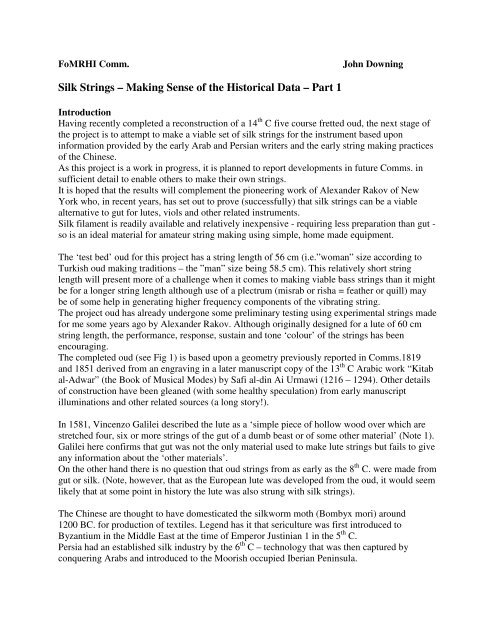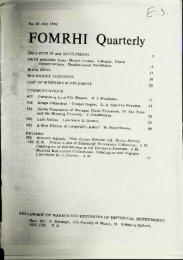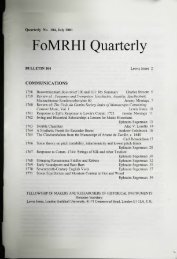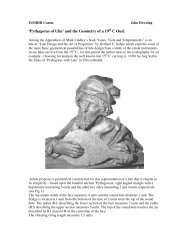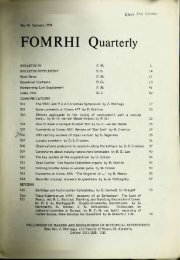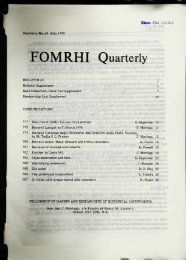Comm 1917.pdf - FoMRHI
Comm 1917.pdf - FoMRHI
Comm 1917.pdf - FoMRHI
Create successful ePaper yourself
Turn your PDF publications into a flip-book with our unique Google optimized e-Paper software.
<strong>FoMRHI</strong> <strong>Comm</strong>. John Downing<br />
Silk Strings – Making Sense of the Historical Data – Part 1<br />
Introduction<br />
Having recently completed a reconstruction of a 14 th C five course fretted oud, the next stage of<br />
the project is to attempt to make a viable set of silk strings for the instrument based upon<br />
information provided by the early Arab and Persian writers and the early string making practices<br />
of the Chinese.<br />
As this project is a work in progress, it is planned to report developments in future <strong>Comm</strong>s. in<br />
sufficient detail to enable others to make their own strings.<br />
It is hoped that the results will complement the pioneering work of Alexander Rakov of New<br />
York who, in recent years, has set out to prove (successfully) that silk strings can be a viable<br />
alternative to gut for lutes, viols and other related instruments.<br />
Silk filament is readily available and relatively inexpensive - requiring less preparation than gut -<br />
so is an ideal material for amateur string making using simple, home made equipment.<br />
The ‘test bed’ oud for this project has a string length of 56 cm (i.e.”woman” size according to<br />
Turkish oud making traditions – the ”man” size being 58.5 cm). This relatively short string<br />
length will present more of a challenge when it comes to making viable bass strings than it might<br />
be for a longer string length although use of a plectrum (misrab or risha = feather or quill) may<br />
be of some help in generating higher frequency components of the vibrating string.<br />
The project oud has already undergone some preliminary testing using experimental strings made<br />
for me some years ago by Alexander Rakov. Although originally designed for a lute of 60 cm<br />
string length, the performance, response, sustain and tone ‘colour’ of the strings has been<br />
encouraging.<br />
The completed oud (see Fig 1) is based upon a geometry previously reported in <strong>Comm</strong>s.1819<br />
and 1851 derived from an engraving in a later manuscript copy of the 13 th C Arabic work “Kitab<br />
al-Adwar” (the Book of Musical Modes) by Safi al-din Ai Urmawi (1216 – 1294). Other details<br />
of construction have been gleaned (with some healthy speculation) from early manuscript<br />
illuminations and other related sources (a long story!).<br />
In 1581, Vincenzo Galilei described the lute as a ‘simple piece of hollow wood over which are<br />
stretched four, six or more strings of the gut of a dumb beast or of some other material’ (Note 1).<br />
Galilei here confirms that gut was not the only material used to make lute strings but fails to give<br />
any information about the ‘other materials’.<br />
On the other hand there is no question that oud strings from as early as the 8 th C. were made from<br />
gut or silk. (Note, however, that as the European lute was developed from the oud, it would seem<br />
likely that at some point in history the lute was also strung with silk strings).<br />
The Chinese are thought to have domesticated the silkworm moth (Bombyx mori) around<br />
1200 BC. for production of textiles. Legend has it that sericulture was first introduced to<br />
Byzantium in the Middle East at the time of Emperor Justinian 1 in the 5 th C.<br />
Persia had an established silk industry by the 6 th C – technology that was then captured by<br />
conquering Arabs and introduced to the Moorish occupied Iberian Peninsula.
Sericulture (as well as the wool industry) continued to prosper in Spain until the late 16 th C when<br />
the Spanish economy failed and punitive measures introduced by the Spanish government –<br />
particularly against the silk industry and its practitioners, the Moors and Jews - brought about the<br />
demise in that country of these two important sectors of agriculture (as well, presumably, as the<br />
dependant gut and silk instrument string trades)<br />
Fig. 1<br />
Historical information about silk oud strings and their construction, sparse though it is, can be<br />
found in various manuscript sources dating from the 8 th C to 14 th C. After the 14 th C there is no<br />
information to confirm for what period of time silk strings continued to be used (but it is likely to<br />
be until such time as metal overspun strings with silk filament core became generally available<br />
world wide – late 18 th C/early 19 th C?) (Note 2)<br />
As the Persians may have learned how to make silk instrument strings from the Chinese,<br />
descriptions of string making found in the early Chinese texts may also be relevant.<br />
One problem facing a would be historical silk string maker is that the early Arab, Persian and<br />
Chinese texts - as primary sources - are inaccessible to most of us in the West so we are<br />
dependant upon English translations that may be incomplete with crucial details ‘lost in<br />
translation’ or couched in confusing terminology by the translators.<br />
Another problem in trying to replicate early silk strings is that the material itself – silk - is not the<br />
same stuff today as it was even in the 19 th C let alone over a millennium ago. The silk of
commerce, produced by the species Bombyx mori, is a species that, over the centuries, has been<br />
selectively bred to produce silk filament suited to specific commercial requirements (for example<br />
silk filament better suited to modern machine processing at high speed rather than by hand).<br />
Furthermore, the properties of cocoon silk (diameter, length, strength etc.) are aslo critically<br />
dependant upon a number of factors - particularly environmental and quality of feed (for<br />
example silk workers in India have recently report a recent significant deterioration in the quality<br />
of cocoon silk - thought to be due to acid rain and its adverse effect on silkworm feedstock). The<br />
same kind of problem likely faces today’s historical gut string makers who are using the guts of<br />
modern breeds of sheep raised under conditions quite unlike those experienced by the now<br />
extinct domesticated breeds of sheep formerly used for string making.<br />
Next to examine the properties of silk the material, past and present – Part 2<br />
Note 1<br />
From a translation of Galilei’s ‘Dialogo della musica e della moderno’ by Oliver Strunk ‘Source<br />
Readings in Music History’ (New York 1950). A scanned copy of the original ‘Dialogo’ is<br />
available as a free download in PDF format from the ‘Internet Archives’ website at<br />
http://www.archive.org.<br />
Note 2<br />
For information, I purchased a set of oud strings in Cairo in 1964 – French manufacture - with<br />
gut trebles and wire over spun basses on silk filament core. Perhaps the store was just glad to get<br />
rid of old stock? I wish now that I had purchased some more sets - for their historical interest<br />
alone!


